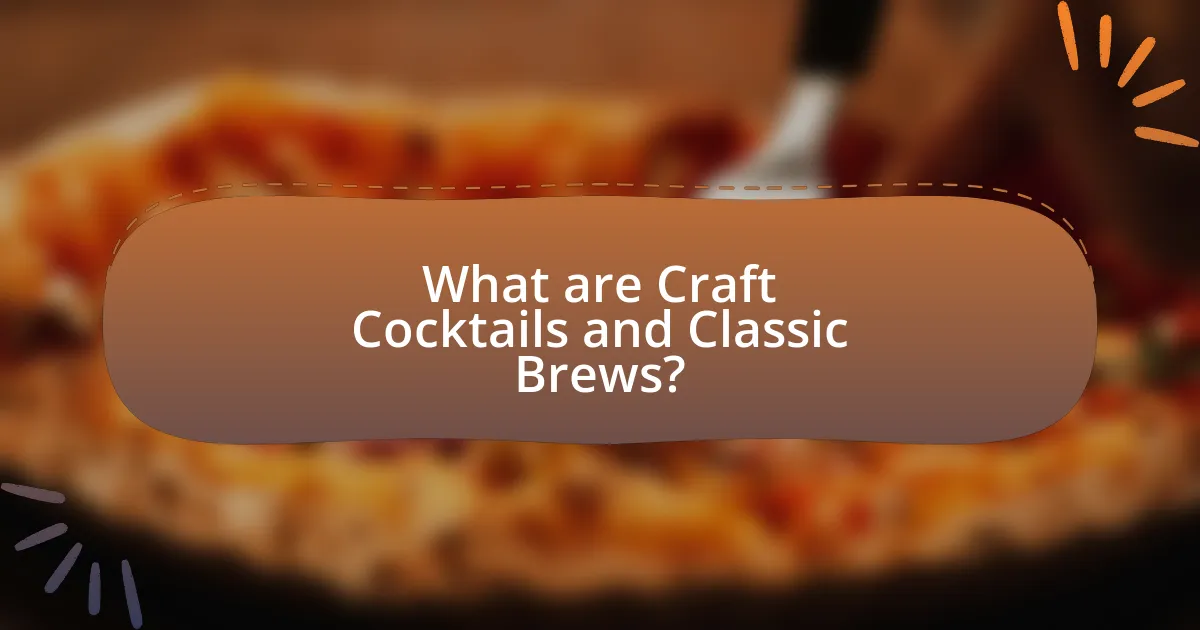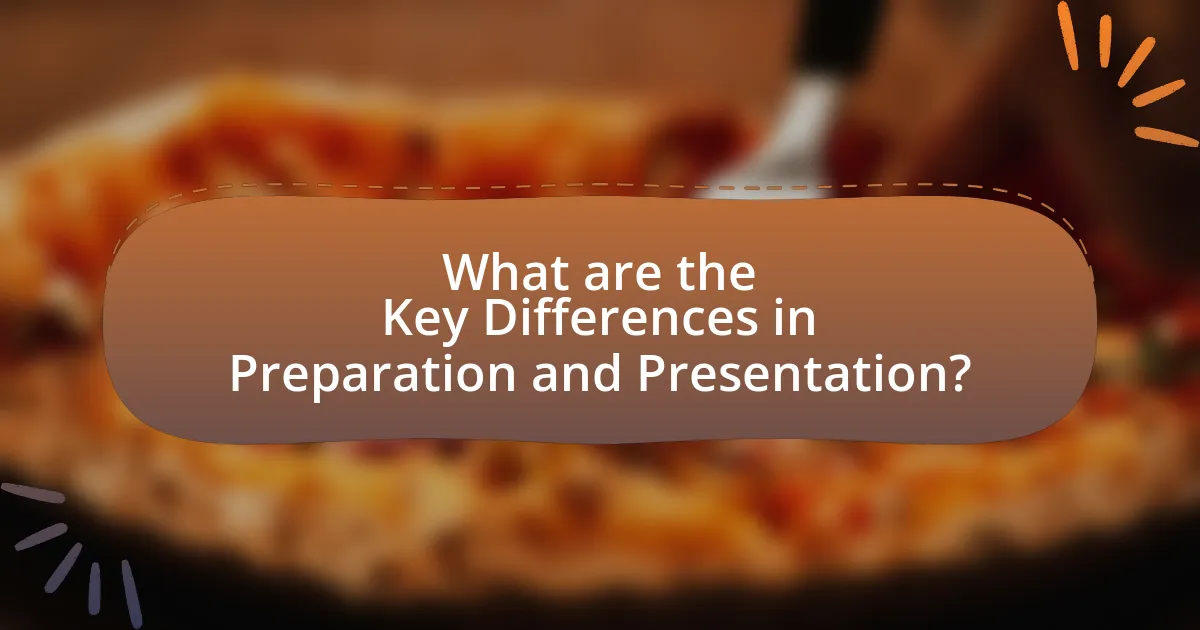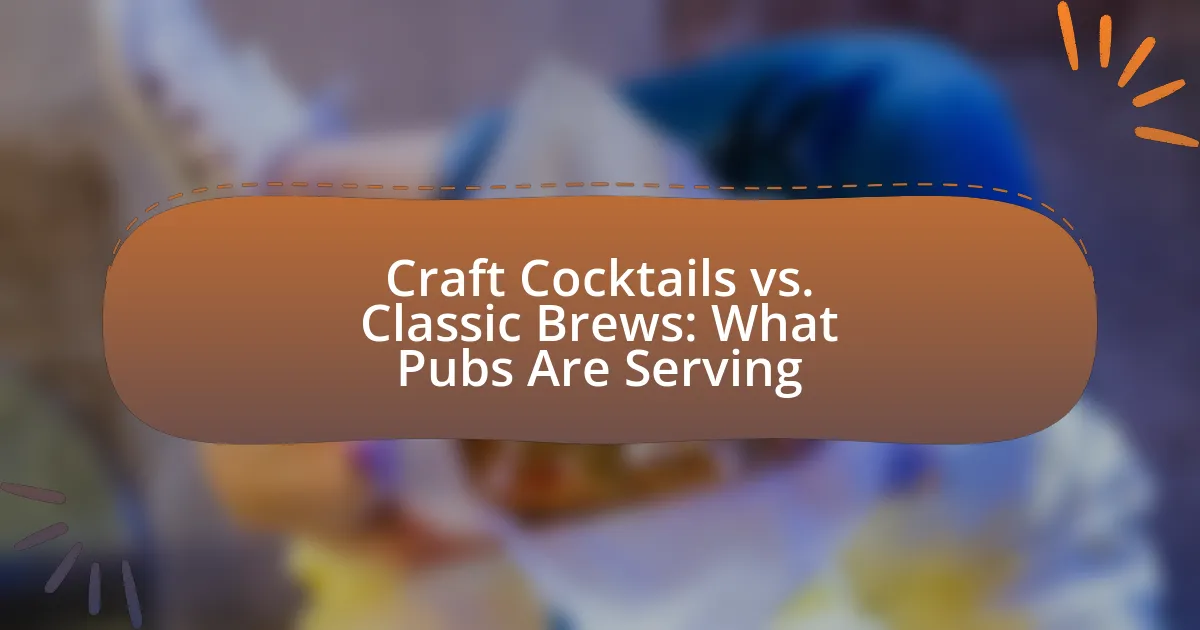Craft cocktails and classic brews represent two distinct categories of beverages commonly served in pubs. Craft cocktails are characterized by their innovative use of high-quality ingredients and artisanal preparation techniques, focusing on unique flavor combinations and presentation. In contrast, classic brews, such as lagers and ales, adhere to traditional brewing methods and established recipes, emphasizing consistency and historical styles. The article explores the differences in preparation, ingredients, and presentation between these two types of drinks, as well as the trends influencing their popularity in pubs, customer preferences, and the evolving landscape of beverage offerings.

What are Craft Cocktails and Classic Brews?
Craft cocktails are innovative drinks made with high-quality ingredients, often featuring unique flavor combinations and artisanal techniques. They emphasize creativity and craftsmanship, typically prepared by skilled bartenders who focus on presentation and taste. Classic brews, on the other hand, refer to traditional beers that have established recipes and brewing methods, often produced by established breweries. These brews are characterized by their consistency and adherence to historical styles, such as lagers, ales, and stouts. The distinction lies in the craft cocktails’ emphasis on experimentation and personalization, while classic brews maintain a focus on time-honored brewing practices.
How do Craft Cocktails differ from Classic Brews?
Craft cocktails differ from classic brews primarily in their preparation and ingredients. Craft cocktails are typically made with high-quality, often artisanal ingredients, and involve intricate mixing techniques, while classic brews, such as beer, are produced through fermentation of grains and are generally simpler in composition. For example, craft cocktails may include fresh herbs, house-made syrups, and unique spirits, emphasizing creativity and flavor complexity, whereas classic brews focus on traditional brewing methods and established recipes, resulting in a more straightforward taste profile.
What ingredients are typically used in Craft Cocktails?
Craft cocktails typically use high-quality spirits, fresh ingredients, and unique flavorings. Common ingredients include artisanal spirits like small-batch gin or whiskey, fresh fruits such as citrus or berries, herbs like mint or basil, and house-made syrups or bitters. The emphasis on quality and freshness is supported by the craft cocktail movement, which prioritizes artisanal techniques and innovative combinations to enhance the drinking experience.
What ingredients are commonly found in Classic Brews?
Classic Brews typically contain four main ingredients: water, malted barley, hops, and yeast. Water serves as the primary solvent in the brewing process, while malted barley provides the sugars necessary for fermentation. Hops contribute bitterness and aroma, balancing the sweetness of the malt, and yeast is essential for fermentation, converting sugars into alcohol and carbon dioxide. These ingredients have been foundational in brewing for centuries, with historical records indicating their use dating back to ancient civilizations.
Why are Craft Cocktails gaining popularity in pubs?
Craft cocktails are gaining popularity in pubs due to their unique flavors and artisanal preparation methods. This trend reflects a growing consumer preference for high-quality, handcrafted beverages that offer a distinct experience compared to traditional drinks. According to a report by the Distilled Spirits Council, craft cocktails have seen a significant increase in sales, with a 20% rise in the craft cocktail segment over the past five years. This shift is driven by patrons seeking innovative ingredients and personalized service, which enhances their overall dining experience.
What trends are influencing the rise of Craft Cocktails?
The rise of craft cocktails is influenced by several key trends, including the demand for unique flavor profiles, the emphasis on artisanal ingredients, and the growing interest in mixology as a skill. Consumers increasingly seek personalized drinking experiences, leading bars to innovate with seasonal and locally sourced ingredients. Additionally, the craft cocktail movement is supported by a cultural shift towards premiumization, where patrons are willing to pay more for high-quality, handcrafted beverages. This trend is evidenced by the growth of craft cocktail bars, which have increased by over 20% in the last five years, reflecting a significant shift in consumer preferences towards sophisticated drinking options.
How do Craft Cocktails enhance the pub experience?
Craft cocktails enhance the pub experience by offering unique flavors and personalized drinks that elevate social interactions. These cocktails often utilize high-quality ingredients and innovative techniques, which attract patrons seeking a more sophisticated drinking experience. According to a study by the National Restaurant Association, 60% of consumers are interested in trying new cocktails, indicating a growing demand for craft options in pubs. This trend not only diversifies the beverage menu but also encourages creativity among bartenders, fostering a vibrant atmosphere that enhances customer engagement and satisfaction.
What role do Classic Brews play in pub culture?
Classic Brews serve as a foundational element of pub culture, embodying tradition and community. They provide a sense of familiarity and nostalgia, often being the preferred choice for patrons seeking a classic drinking experience. Classic Brews, such as ales and lagers, are typically associated with social gatherings and local identity, reinforcing the pub as a communal space. Historical data indicates that these brews have been staples in pubs for centuries, contributing to their cultural significance and the overall atmosphere of conviviality.
How have Classic Brews evolved over time?
Classic Brews have evolved significantly over time, transitioning from traditional recipes to incorporate modern brewing techniques and diverse ingredients. Historically, classic brews such as lagers and ales were primarily produced using local ingredients and methods passed down through generations. In recent decades, the craft beer movement has introduced innovative brewing styles, flavors, and techniques, leading to a resurgence of interest in classic brews with contemporary twists. For example, the introduction of hops varieties and adjuncts has allowed brewers to create unique flavor profiles while maintaining the essence of classic styles. This evolution reflects a broader trend in the beverage industry, where consumer preferences for quality and variety have driven brewers to experiment while honoring traditional brewing heritage.
What are the most popular Classic Brews served in pubs?
The most popular classic brews served in pubs include lagers, ales, stouts, and porters. Lagers, such as Budweiser and Heineken, are widely consumed due to their crisp taste and refreshing qualities. Ales, including pale ales and IPAs like Sierra Nevada, are favored for their hoppy flavors. Stouts, particularly Guinness, are renowned for their rich, dark profiles, while porters offer a similar but slightly sweeter experience. These brews have historical significance and are staples in pub culture, often representing traditional brewing methods and regional preferences.

What are the Key Differences in Preparation and Presentation?
The key differences in preparation and presentation between craft cocktails and classic brews lie in their complexity and visual appeal. Craft cocktails typically involve intricate preparation methods, such as muddling, shaking, or layering, and often include a variety of fresh ingredients, unique flavor combinations, and garnishes that enhance their aesthetic. In contrast, classic brews, like beers, are generally simpler in preparation, focusing on fermentation and brewing processes, with less emphasis on visual presentation. For example, craft cocktails may be served in specialized glassware with elaborate garnishes, while classic brews are usually presented in standard pint glasses or bottles, emphasizing the drink’s color and carbonation rather than decorative elements.
How are Craft Cocktails prepared compared to Classic Brews?
Craft cocktails are prepared with a focus on creativity and high-quality ingredients, while classic brews are typically made using traditional methods and established recipes. Craft cocktails often involve techniques such as muddling, shaking, and layering, utilizing fresh herbs, artisanal spirits, and house-made syrups to enhance flavor complexity. In contrast, classic brews, like lagers or ales, rely on a straightforward brewing process that includes fermentation, boiling, and conditioning, emphasizing consistency and adherence to style guidelines. The preparation of craft cocktails allows for experimentation and personalization, whereas classic brews prioritize time-honored brewing practices and flavor profiles.
What techniques are unique to Craft Cocktail preparation?
Craft cocktail preparation employs techniques such as infusion, house-made syrups, and precise temperature control. Infusion involves steeping ingredients like herbs or fruits in spirits to extract unique flavors, enhancing the cocktail’s complexity. House-made syrups, often crafted from fresh ingredients, provide a tailored sweetness that contrasts with mass-produced options. Precise temperature control, achieved through methods like shaking or stirring, ensures optimal dilution and texture, which is crucial for the cocktail’s overall balance. These techniques distinguish craft cocktails from classic brews, emphasizing creativity and quality in the mixology process.
What is the typical brewing process for Classic Brews?
The typical brewing process for Classic Brews involves several key steps: mashing, boiling, fermenting, conditioning, and packaging. During mashing, malted grains are mixed with hot water to convert starches into sugars. This mixture, known as wort, is then boiled with hops to add bitterness and aroma. After boiling, the wort is cooled and yeast is added for fermentation, where sugars are converted into alcohol and carbon dioxide. Following fermentation, the brew is conditioned to develop flavors before being packaged for serving. This process is foundational in traditional brewing methods, ensuring consistency and quality in the final product.
How does presentation differ between Craft Cocktails and Classic Brews?
Presentation differs significantly between craft cocktails and classic brews. Craft cocktails are typically served in unique glassware, often garnished with fresh herbs, fruits, or intricate decorations, emphasizing aesthetics and creativity. In contrast, classic brews, such as beers, are generally presented in standard pint glasses or bottles, focusing more on the beverage itself rather than elaborate presentation. This distinction highlights the artisanal approach of craft cocktails, which often involves a curated experience, while classic brews prioritize simplicity and tradition in their serving style.
What garnishes are commonly used in Craft Cocktails?
Common garnishes used in craft cocktails include citrus peels, herbs, and edible flowers. Citrus peels, such as lemon or orange twists, enhance aroma and flavor, while herbs like mint or basil add freshness. Edible flowers, such as violets or nasturtiums, provide visual appeal and unique taste profiles. These garnishes not only elevate the drink’s presentation but also contribute to the overall sensory experience, making them essential in the craft cocktail scene.
How are Classic Brews typically served and presented?
Classic Brews are typically served in traditional glassware, such as pint glasses or mugs, which enhance the drinking experience. The presentation often includes a frothy head for beers, indicating freshness and proper pouring technique. Additionally, Classic Brews may be accompanied by garnishes like lemon wedges or olives, depending on the specific brew, to complement the flavors. This serving style is rooted in historical practices, as many pubs have maintained these traditional methods to preserve the authenticity and cultural significance of the beverages.

What are the Trends and Customer Preferences in Pubs?
Trends in pubs indicate a growing preference for craft cocktails over traditional brews. Recent surveys show that 60% of consumers aged 21-35 prefer unique, artisanal cocktails, reflecting a shift towards personalized drinking experiences. Additionally, the rise of mixology has led to an increased interest in high-quality ingredients and innovative flavor combinations, with 70% of patrons willing to pay more for craft cocktails. This trend is supported by the National Restaurant Association, which reported that 40% of bars are expanding their cocktail menus to meet customer demand for creativity and quality.
What are the current trends in Craft Cocktails at pubs?
Current trends in craft cocktails at pubs include a focus on locally sourced ingredients, innovative flavor combinations, and the use of artisanal spirits. Pubs are increasingly emphasizing sustainability by incorporating seasonal produce and house-made mixers, which enhances the freshness and uniqueness of their offerings. Additionally, the rise of low-alcohol and non-alcoholic cocktails reflects a growing consumer preference for healthier options. According to a 2023 report by the Distilled Spirits Council, craft cocktails have seen a 15% increase in popularity over the past year, driven by these trends.
How are seasonal ingredients influencing Craft Cocktail menus?
Seasonal ingredients are significantly influencing craft cocktail menus by enhancing flavor profiles and promoting local sourcing. Bartenders are increasingly incorporating fresh, in-season fruits, herbs, and spices to create unique and vibrant cocktails that reflect the changing seasons. For example, summer menus often feature berries and citrus, while autumn may highlight apples and spices like cinnamon. This trend not only elevates the taste experience but also supports local farmers and reduces carbon footprints associated with transportation. According to a 2022 survey by the United States Bartenders’ Guild, 68% of bartenders reported using seasonal ingredients to attract customers seeking fresh and innovative drink options.
What innovative techniques are bartenders using for Craft Cocktails?
Bartenders are using techniques such as molecular mixology, barrel-aging, and infusion to create innovative craft cocktails. Molecular mixology involves using scientific methods to manipulate the textures and flavors of ingredients, resulting in unique presentations like foams and gels. Barrel-aging allows cocktails to develop complex flavors over time, similar to traditional spirits, enhancing depth and character. Infusion techniques, where spirits are infused with herbs, fruits, or spices, provide customized flavor profiles that cater to contemporary tastes. These methods reflect a growing trend in the cocktail industry towards creativity and experimentation, appealing to consumers seeking novel drinking experiences.
What do customers prefer: Craft Cocktails or Classic Brews?
Customers generally prefer craft cocktails over classic brews. A survey conducted by the National Restaurant Association in 2022 indicated that 60% of consumers are more likely to order craft cocktails when dining out, reflecting a growing trend towards unique and artisanal drink experiences. This preference is driven by the desire for innovative flavors and personalized options that craft cocktails offer, contrasting with the more traditional appeal of classic brews.
How do customer demographics affect drink preferences?
Customer demographics significantly influence drink preferences, as factors such as age, gender, income, and cultural background shape individual choices. For instance, younger consumers often prefer craft cocktails due to their unique flavors and presentation, while older demographics may lean towards classic brews, reflecting traditional tastes. Additionally, income levels can dictate the willingness to spend on premium drinks; higher-income individuals are more likely to indulge in artisanal cocktails, whereas budget-conscious consumers may opt for standard beers or well drinks. Research by the Beverage Marketing Corporation indicates that millennials are driving the growth of craft cocktails, with a 20% increase in sales from 2015 to 2020, highlighting the impact of age demographics on drink trends.
What factors influence a customer’s choice between Craft Cocktails and Classic Brews?
A customer’s choice between Craft Cocktails and Classic Brews is influenced by factors such as taste preferences, social context, and perceived quality. Taste preferences play a significant role, as individuals may favor the unique flavors and artisanal nature of craft cocktails over the traditional taste of classic brews. Social context also impacts this decision; for instance, customers may opt for craft cocktails in upscale settings or during special occasions, while classic brews might be preferred in casual environments. Additionally, perceived quality affects choices, with craft cocktails often associated with higher quality ingredients and craftsmanship, leading customers to choose them for a premium experience.
What are some tips for choosing between Craft Cocktails and Classic Brews at a pub?
When choosing between craft cocktails and classic brews at a pub, consider your flavor preferences and the occasion. Craft cocktails often feature unique ingredients and innovative combinations, appealing to those seeking a distinctive taste experience. In contrast, classic brews, such as lagers or ales, provide familiar flavors and are typically more straightforward in taste. Additionally, evaluate the pub’s specialty; if they are known for their craft cocktails, it may be worth trying one, while a pub with a strong beer selection might offer a better experience with classic brews.
